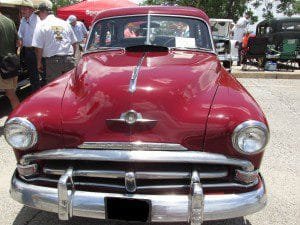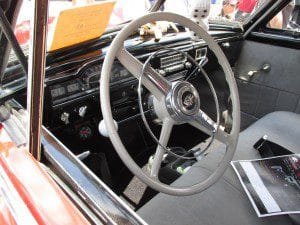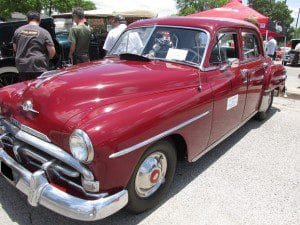The automobile featured in this article is the 1952 Plymouth Cranbrook 4 Door Sedan. The Plymouth Cranbrook first came out in 1951 as Plymouth’s top of the line entry. It replaced the Special Deluxe model when Plymouth changed its naming scheme.

The Korean War adversely affected production since Chrysler was awarded a government contract to supply war materiel. The 1952 Plymouth Cranbrook itself was similar to the 1951 model but production numbers were quite different. Plymouth Cranbrook 1951 production numbers totaled about 550,000 vehicles. In 1952 that figure fell to 368,000. The following year saw production up to 400,000.
Plymouth Cranbrook Styling
The Plymouth Cranbrook was built as a Sedan, Coupe and Convertible. Any way you look at it the Plymouth Cranbrook exudes a conservative style. Some would call this model the All American car with it’s large fenders and bumpers. The Cranbrook with it’s six cylinder engine and weight meant that it would never be accused of being a performance car.

The body was welded steel and the frame was arc welded. Chrysler styling with the late 1940’s models was a matter of adding a lot of chrome without much thought to it. Their cars from 1950 through 1952 were cleared somewhat of the excess chrome but the boxy silhouette remained.
Chrysler Corporation bought their bodies from Briggs. Briggs Manufacturing was a major company in the automotive body and upholstery field. Briggs produced bodies for Ford, Chrylser, Packard and some independents. Chrysler acquired Briggs’s American car body operation in 1953 for $35 million. At that time Brigg’s largest customer was Plymouth.

In some ways the Plymouth Cranbrook delivered what Chrysler Corporation President K.T. Keller wanted to see in an automobile, that is, a high roofed car that people could wear their hats in. Keller’s influence on Chrysler meant many years of very functional yet unfashionable automobile designs. K.T. Keller joined Chrysler Corporation as Vice President in 1926; became President in 1935 and Chairman in 1950. While Chrysler was led by Keller production did reach the one million unit mark.
1952 Plymouth Cranbrook Specifications
The 1952 Plymouth Cranbrook came with a 217-cid flathead straight-six engine, which was rated at 97 hp. This was the same engine offered in the 1951 models.
Transmission was a three speed column mounted manual.
Brakes were hydraulic four wheel drum. Brakes consisted of Cyclebond brake shoes. These were brake linings without rivets. The brake lining was bonded to the steel shoe by pressure and heat.
Front suspension were coiled springs while the rear suspension sat on leaf springs.
The car’s wheelbase was 118.5 inches, it’s overall outside length 193,875 inches, width was 73.375 inches and height 64.625 inches.
The 1952 Plymouth Cranbrook had an average weight of about 3,300 lbs.
The new car base price of the 1952 Plymouth Cranbrook Sedan was $1,690.
You may also enjoy the AutoMuseumOnline articles on the links below…
1952 Packard Patrician Convertible
VIN Plates and Stamps on Vintage Vehicles
Plymouth Cranbrook Collector Car
The Plymouth Cranbrook is not exactly a head turning car. As mentioned above, the styling was very conservative but at the same time the Cranbrook also represents the thinking of Chrysler at that time and the influence of K.T. Keller. In that respect there’s a lot to the Plymouth story of such a relatively plain looking automobile and as such it makes the model a good collector car. It’s also a relatively inexpensive collector car and makes a good start to a collection.

Parts appear to be easily accessible if you plan on picking up a project model. All the mechanical parts are available through many auto parts stores and the prices are very reasonable.The Plymouth Cranbrook is considered a solid built car that’s easily repairable.
As of this writing the price range seen for the 1952 Plymouth Cranbrook is from about $15,000 to $30,000. Price will depend on restoration degree, mechanical soundness as well as actual miles. Non restored models will likely be well under $10,000.
(Article and photos copyright 2014 AutoMuseumOnline)